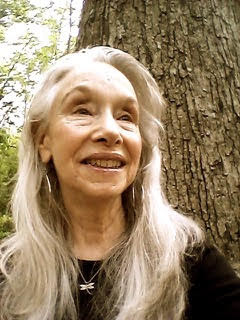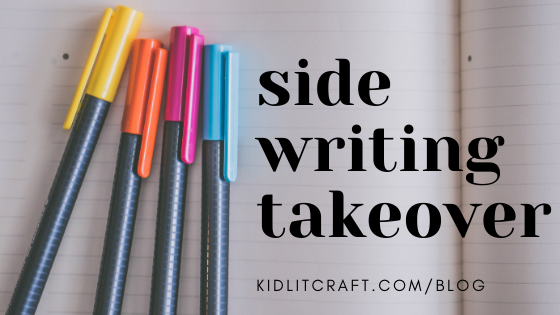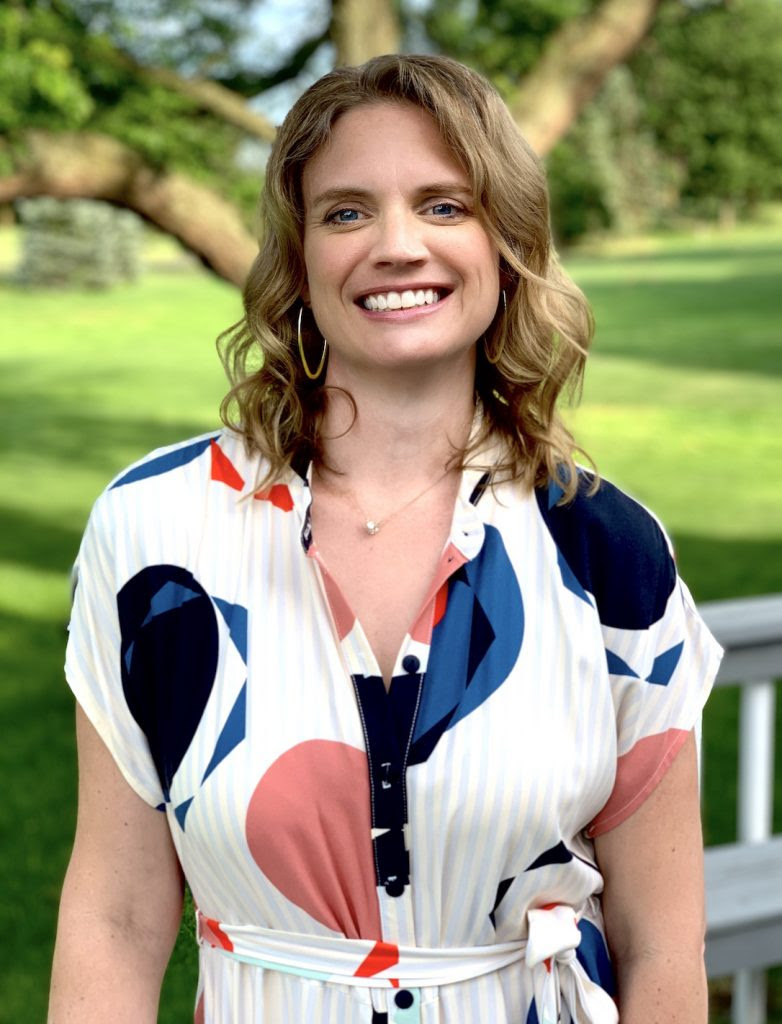interview by Erin Nuttall
Sidewriting Takeover brings together writers of picture books, middle grade, and young adult fiction to explore how writing outside of a draft can help deepen your drafts and revisions. Each writer shares an exercise that they’ve found helpful. If you missed our initial post: START HERE.
It was thanks to Louise’s patient, kind insistence on freewriting that I was first able to see how powerful it could be. Her ideas and exercises opened my mind to the possibility that I misjudged what free/sidewriting can do. She helped me take two cardboard characters and figure out who they are, what they sound like, and what they want–she even got me meditating to connect with my characters. It was magic! Just like Lou herself. –Erin
KidLit Craft: What do you think the difference is between sidewriting and freewriting?
Louise Hawes: For me, the difference is in the names: “Side” writing is a broad category, covering any writing you do to flesh out and learn about your story. It might not become part of the final draft, but it’s done “on the side,” to help you get a closer, deeper understanding. It could include a scene between two characters who’ll never actually meet in the draft; something that happens in the story’s past or future; the description of a character or setting that you haven’t seen clearly yet or have omitted entirely from your draft.
Now, any of these things can be freewritten; that is, written without interference from your internal editor, all in one forward rush. But the kind of freewriting I ask my students to do is also always a direct, first-person response from an individual character. Which is why, when a student has a question about their story, nine times out of ten, my answer is, “Ask your character.”
KLC: Were you always a free writer?
LH: No. My shady secret is that I am what Annie Dillard calls a “lapidary” writer. In other words, having been raised by a father who lived in his head and a mother who acted from her heart, those two parts of me, mind and heart, have spent years fighting for control of my work. My mind aims for perfection, polishing, polishing, polishing. It literally cannot leave a paragraph, a sentence, or, sadly, a word behind until it’s been worked and reworked and re—well, you get the idea.
I’ve finally discovered a way of dumping this inner perfectionist for at least part of the journey. I learned through trial and error that the keyboard, domain of the delete key, precursor to print, was where my perfectionist tended to take control. Pencil and paper was where my heart led the way. Which is why I began to “channel” my characters through freewriting. Like poetry, freewrites are a way I ditch my inner critic and make the switch from common sense to felt sense, from thoughts to emotions.
KLC: How has free writing become a part of your writing process?
LH: For the last three decades, I have never started any project, whether novel, picture book, graphic novel, or novel-in-verse, without a pre-draft stage. During this stage, I don’t type a single word; instead, I wait until I have a whole notebook full of first-person letters to me from my characters. For each freewrite, I use no computer; I write by hand, without revising, erasing, or stopping until a character is finished with me. No resistance, no control, no perfectionism.
This way, if I need to take a break from a project—a few days, weeks, even months, I have only to pick up that notebook when I start work again: all those voices are there, talking to me again. And yes, even during the drafting stage, if I find myself stumped, wonder about a detail or a scene, I’ll stop and check-in with the character involved. Freewriting builds a bridge from my own heart to my character’s, a bridge I can cross any time I need to.
KLC: What role does meditation play in your freewriting?
LH: I never freewrite without first doing a meditation with the fictional person I’m reaching out to. I close my eyes and spend three to five quiet minutes with my character, visualizing him or her. I picture in detail their clothing, mannerisms, facial expressions, posture, gestures, voice color — everything that makes them unique. I let the character do what he needs to; she may sit down beside me to talk—if she’s feeling friendly; if he’s scared or angry, he may turn his back and walk away; she may need a hug. My role is to be a supportive, affirming witness.
After this meditation, I open my eyes and pick up a pencil. (A computer works for some, but never has for me.) I ask the character something I want to learn from them and explain I need their response in first-person. (For characters who aren’t crazy about talking at length, I remind them that their answer will help me recall and be sure of what they want on record!)
KLC: As a mentor, how do you ask/encourage students to engage with freewriting?
LH: First of all, it’s important to remember that every character and each writing project will probably require different “ways in.” Sometimes freewriting with a main character’s sibling can crack open a whole story; other times exploring a character’s dreams is key. So asking the right questions is crucial.
Second, the sort of freewriting I do may not be best for you. Which is why the students I work with are free to explore all sorts of approaches, from walking meditations (thinking things over outdoors and on the move) to a technique called “clustering,” a free association process used in corporate brainstorming. Some folks feel most at ease letting their character choose a piece of music or a photograph to respond to. I’ve worked with several writers whose characters love to draw or paint their responses. All good, all rich and deep entry points. (For a wonderful collection of right-brain exercises, see Writing the Natural Way, by Gabriele Rico, who coined the term, “clustering.”)
Sidewriting Challenge: Questions for Focused Freewriting
Free write questions can be as general as, Why do you want me to tell your story? (This is almost always a good start, a solid relationship-builder for you and your protagonist.) Later in the process, areas of inquiry may be as specific and nitty-gritty as, I’m having a terrible time with this scene. Can you tell me what you feel when X confronts you about Y?
First memory, recurring nightmares, earliest punishment, most respected adult—the list of questions to ask is endless, but often boils down to, “ask it slant.” Like people in real life, most characters can’t verbalize, probably don’t even know, what their personal strengths and weaknesses are, what triggers their deepest fears, what their spirit needs to grow and thrive. It’s up to an author to keep asking heartful questions, to keep building freewrite bridges till the answers—and the story, come clear.

Louise Hawes is a faculty member at VCFA’s Writing for Children and Young Adults MFA program and has published books for readers of all ages. Her novels for middle graders and young adults have earned two NJ Writing Fellowships, the New Jersey Author’s Award, and recognition from the Children’s Book Council, IRA, YALSA, Bank Street College, Booksense, and the NYC Public Library.
Recently she’s been working on Big Rig a middle grade novel that will be released by Peach Tree in summer 2022 about 11-year old Hazmat, chief navigator and homeschool student for her trucker dad. (Yes, they live on the road, and Hazel wouldn’t want it any other way!) Her other projects include A Flight of Angels, a graphic novel, and The Language of Stars, a novel that includes prose, poetry, and play scripts. Louise has published short fiction in five YA anthologies, while her stories for adult readers are collected in Anteaters Don’t Dream.
In addition to lecturing at conferences and colleges nationwide, Louise has served as John Grisham Visiting Author at the University of Mississippi, Writer in Residence at the University of New Mexico, and Reading Initiative Author at the Mississippi University for Women. To read some of Louise’s lectures or learn more about her books, check out: www.louisehawes.com
For more of our Sidewriting Takeover series, check out these posts:
Side-thinking and Personality with Aimee Lucido
Gossip Your Way Through the Story with Mary Winn Heider
Writing for Emotional Power with Sarah S. Davis
Dive into Character Relationships with David Macinnis Gill
Exploring a Character’s Misbelief with Jen Jobart
We send out a newsletter once a month with writing inspiration, craft tips, featured authors and more. Sign up here:
Erin Nuttall holds an MFA in Writing for Children and Young Adults from Vermont College of Fine Arts and is an active member of SCBWI and ALAN. She lives outside of Chicago with her family where she writes stories for middle grade and young adult readers that offer a humorous take on friendship, identity, feminism, and romance.





[…] trying to get deeper into their desire. (You can read more about this freewriting technique in this interview.) Your character might say something like, “I want to win this battle!” But everyone wants to […]